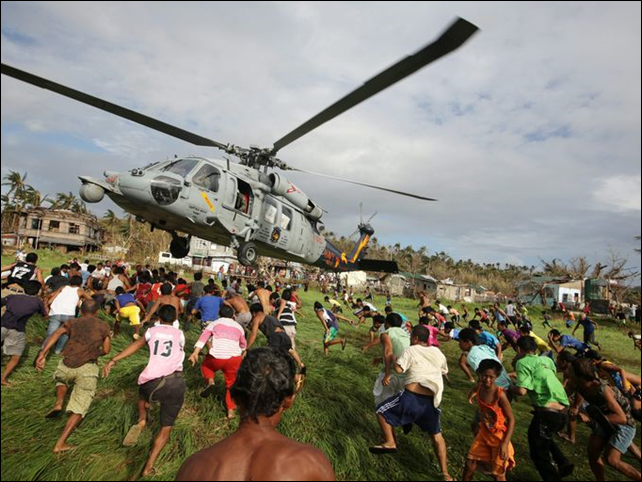Exodus from hell: Residents flee typhoon-ravaged Tacloban
By Calum MacLeod
16 November 2013 TACLOBAN, Philippines (USA TODAY) – Slicing up a steaming pig, the Lloren family quickly attracted buyers in central Tacloban on a street wrecked by Typhoon Haiyan. After a week of hell, with no cooked food nor any emergency relief, hungry residents gratefully seized the chance Thursday to buy their favorite lechón — a whole roasted pig. Some butchered meat has appeared on sidewalk tables here in recent days, often close to bloated corpses, but residents of this devastated city in the central Philippines have grown understandably nervous of its provenance. The city slaughterhouse was transformed into a dark, stinking morgue, powerless like the rest of Tacloban. The latest figures put the death toll across the Philippines from Haiyan at 3,633, with another 12,487 injured. Many of the bodies remain tangled in piles of debris or are lining the road in body bags that seep fetid liquid. After the initial days of chaos, when no aid reached the more than 600,000 people rendered homeless, an international aid effort is gathering steam. “We’re starting to see the turning of the corner,” said John Ging, a top U.N. humanitarian official in New York. He said 107,500 people have received food assistance so far and 11 foreign and 22 domestic medical teams are in operation. Meanwhile, many residents of the hardest-hit islands are looking to flee.
Despite demand for their pig, hauled here squealing on a three-hour motorbike ride, the Llorens planned to leave Friday for a relative’s house in Mindanao, a southern island less affected by Haiyan. “Many friends and neighbors say they will leave, too,” said Fav Lloren, who has sold lechón here for 18 years, but doubts she will return for several months. “The poor people will stay here; they can’t afford to leave.” By road, sea, and air, many residents choose to join the swelling exodus. The reasons are obvious. In this city of about 250,000 people, no home was spared Haiyan’s fury, so families must improvise shelter as best they can. Although relief supplies are arriving, food, water and gasoline remain scarce. Electric power will not return for at least two months. And fears are rising about the outbreak of disease. The exodus also confirms the rich-poor divide in the Philippines, where more than 25% of the population live in poverty, surviving on less than $2 a day. Unless people have family elsewhere to support them or their own means to get by, leaving the disaster area is not viable. “I don’t have money to travel anywhere,” said Esmerelda Encomio, 59, who used to sell taro root snacks, earning $140 a month, near the Llorens’ now destroyed lechón store. “Only people with no money will stay here.” Residents of Tacloban and the surrounding area on Leyte island mostly head for Manila, the sprawling Philippine capital, or Cebu, an island southwest of Leyte. Some try often-clogged roads, or hunt ferries, while many hundreds crowd the city’s wrecked airport terminal for free flights on Philippine and U.S. military cargo planes or flights on two commercial carriers. Patience and perseverance are essential. “I’ve been waiting two days here for any plane,” said Michael Zelabarrea, 21, as he shared a friend’s umbrella to avoid the hot sun and frequent rainstorms that fell Thursday on the long line of people queuing to leave. [more]
Exodus from hell: Residents flee typhoon-ravaged Tacloban


Praying for all the victims of the typhoon haiyan.. My Poetry to all the victim. http://bit.ly/1aqHghV